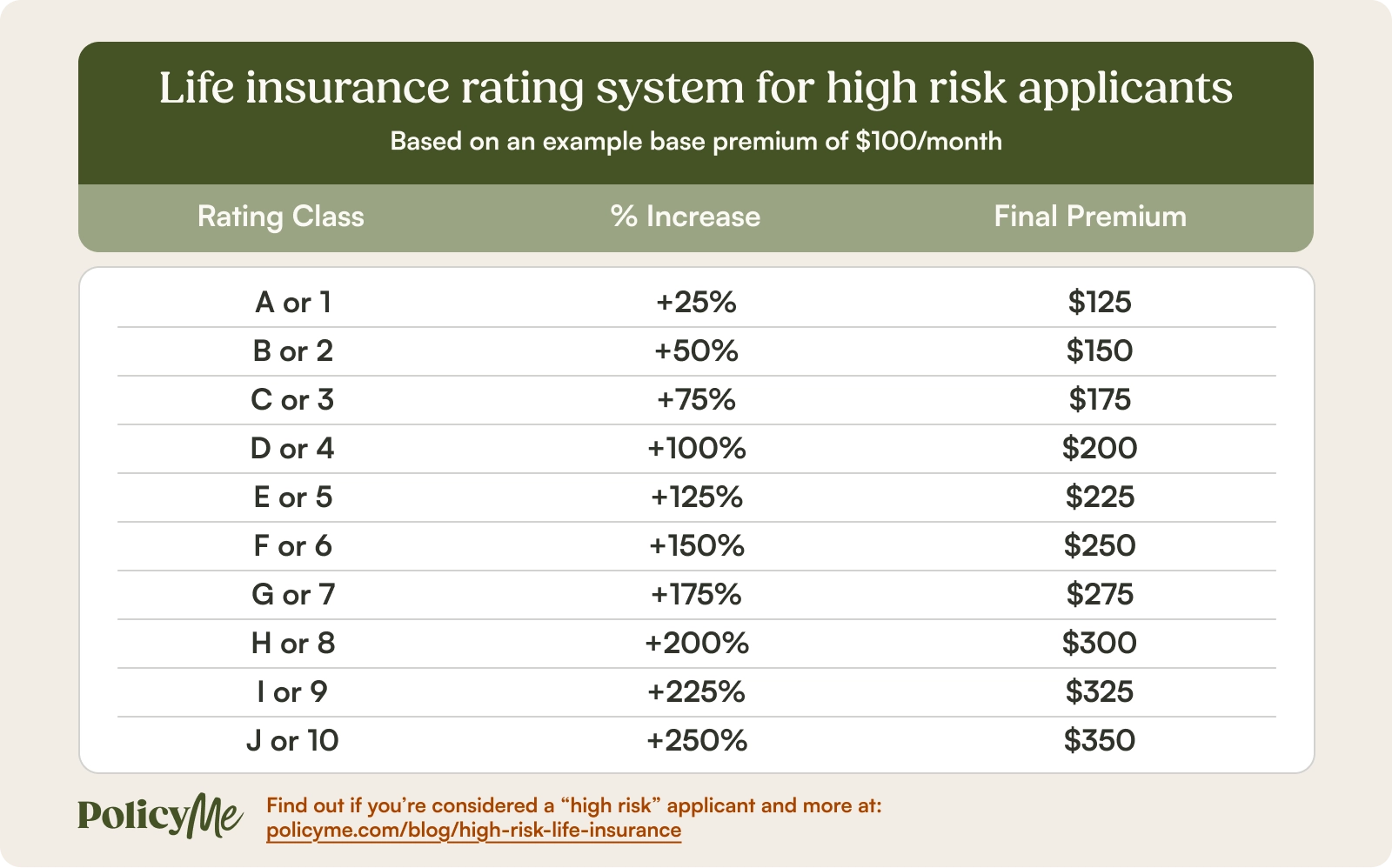Your Guide to High-Risk Life Insurance
What is high-risk life insurance?
High-risk life insurance refers to policies for people living with lifestyle risks or medical risks and, as a result, have a higher-than-average risk of passing away prematurely and triggering early payouts.
“High risk” is not a type of insurance; rather, it’s a designation for the policyholder based on lifestyle, health, or occupation as revealed during the application process. A high-risk policy just means that the underwriting on a standard policy is adjusted for the extra risk.
Lifestyle risks include:
- Having a dangerous job like mining or construction
- Engaging in thrill-seeking activities like skydiving or motorcycle racing
- Having unhealthy lifestyle habits like smoking, excessive drinking, or drug abuse
Medical conditions that can make you higher-risk include:
If you pass away while your high-risk policy term is active, your loved ones will receive a tax-free lump sum known as a death benefit.
How much high-risk life insurance costs in Canada
The higher the risk of premature passing, the higher the life insurance premiums will be—like 25% to 200% higher, depending on the increased risk factors.
When applying for life insurance as a “high-risk” individual, a provider might assess your eligibility for approval as part of your life insurance application based on these factors:
- How old you were when you were diagnosed
- Whether you’ve developed complications
- How well you’re currently managing your condition
Then, insurers will calculate your premiums using well-established industry ratings with corresponding percentage increases to your monthly life insurance cost. The ratings range from A to J or 1 to 10, with A and 1 being the lowest ratings. The higher (riskier) a condition is rated, the pricier your premium will be.
Here’s an example of a rating range:

Who is considered “high risk” for life insurance?
Jobs, medical conditions, and risky hobbies can make someone “high risk” when it comes to life insurance. Here’s a non-exclusive list for each category.
What occupations are considered high risk?
- Underground miners
- Farmers and ranchers
- Commercial fishermen
- Construction workers
- Roofing specialists
- Steelworkers
What health issues are considered high risk?
- Crohn's disease
- Heart disease
- Organ transplants
- History of cancer
- Kidney disease
- High cholesterol
- Smoking cigarettes or cigars
- Chewing tobacco or use of other tobacco products
What hobbies are considered high risk?
- Skydiving
- Scuba diving
- Bungee jumping
- Rock climbing
- Racing (boat, car, bike, skiing)
- Parachuting
- Hang gliding
Remember: A hobby is something you do repeatedly. If you’re just trying something one or twice, you generally won’t be considered high risk for life insurance.
“Being ‘high risk’ is just an underwriter classification. It doesn’t take away the probability of you getting coverage and protecting your family.” —Erik Heiderbrecht, Life Insurance Advisor
How to find the best affordable high risk life insurance
Finding affordable life insurance when you’re considered “high risk” can feel daunting—but it’s not impossible. Here’s how you can find the coverage you need without breaking your budget.
Step 1: Shop around
Insurers differ in how they treat a particular health condition in their underwriting process. Aim to get three different life insurance quotes to find the option with the coverage you need at a price you can pay.
Step 2: Manage your health condition and re-apply
Look for an insurer that will allow you to be reassessed within a year or two of buying your policy. If you manage your condition effectively and become healthier as a result, you could unlock lower premium payments in the future.
Step 3: Get no-medical coverage as a last resort
No-medical life insurance coverage doesn’t require an extensive medical exam—but this means that the provider will assume you’re high risk and will charge equally high premiums.
If you’re like most Canadians, term life insurance coverage is the type of life insurance that is most beneficial—and most affordable. Try getting standard term life insurance coverage first and use no-medical life insurance as a backup.
The best high-risk life insurance in Canada
The top three best high-risk life insurance companies in Canada are PolicyMe, Canada Protection Plan, and Manulife. Here’s how they stack up:
Here’s a detailed comparison of the top three life insurance options for high-risk Canadians, with pros and cons for each company.
PolicyMe high risk life insurance
PolicyMe offers term life policies with no medical exam required for many applicants. This is a quick and affordable pick if you have a health condition and want coverage without extensive testing.
Canada Protection Plan high risk life insurance
CPP specializes in guaranteed-issue and simplified-issue policies. These could work for high-risk applicants who might be declined elsewhere but still need guaranteed coverage.
Manulife high risk life insurance
Manulife has flexible underwriting for higher coverage amounts and permanent policies. This could be a good fit for high-risk individuals who want more comprehensive protection and are willing to complete a medical exam.
FAQ: high risk life insurance

Bonnie Stinson is an insurance writer and researcher in Toronto with a decade of experience producing helpful, accurate content for Canadians. They have published resources for some of Canada's most innovative and consumer-trusted companies in the health, legal, and fintech sectors.
Bonnie Stinson is an insurance writer and researcher in Toronto with a decade of experience producing helpful, accurate content for Canadians. They have published resources for some of Canada's most innovative and consumer-trusted companies in the health, legal, and fintech sectors.
